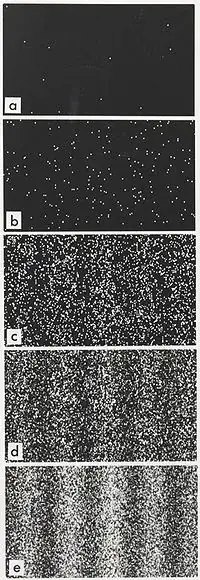I have heard about electrons surfing on wake fields which got me thinking. Are there analogs to reefs for these waves and can these waves break as ocean waves do when they hit a reef?
3 Answers
The wave nature of particles is only measured in probability distributions, as in the double slit single electron accumulation,

The first slide on top shows a few electrons going through the slit and hitting the screen. They hit it as individual particles.
The probability distribution accumulated shows an interference pattern , similar to the interference that a sea wave would show passing through two breaks of a barrier.
The distribution for the water waves is an energy distribution, more energy in the hills than in the troughs. The probability distribution of the electrons also shows in the end, as far as energy goes , more accumulated energy in the hills than in the troughs. The difference lies in the definition of what the "wave" represents. Macroscopically a wave is a collective phenomenon of energy distribution in an ensemble . Microscopically the individual electron is not a wave in an energy distribution. It is the probability of which way it will scatter through the slits that is described mathematically as a wave, and manifests in the interference pattern.
So there are similarities but also drastic differences, because if one took small water wave samples and threw them at the barrier, they would just go through the holes straight.
- 236,935
The short answer is yes. I have made comments about phenomena that manage to do this here, here, here, and here. A more detailed answer can be found here.
In electromagnetic waves, the concept of breaking is slightly different than in neutral fluids like water. However, the mathematical definition is still the same. Namely, that the amplitude of the wave reaches a point where the gradient scale length on the steepened edge approaches zero, called a gradient catastrophe. For instance, in magnetosonic waves the physical quantity responsible for the steepening is the current density. If the driving source (e.g., coronal mass ejection) and loss terms balance or the loss can exceed the source, then there will not be wave breaking. In general, if there is insufficient energy dissipation to limit any wave steepening, then the wave will break. You should note that were it not for energy dissipation, the sound waves produced by human speaking would steepen into shock waves.
In your example of wake field acceleration (WFA), I do not think that type of wave steepens. WFA is typically driven by a laser-like source of energy, which is effectively a quasi-static electric field. These types of fields do not really steepen, in the sense that I mentioned above, I don't think. The waves driven by the Weibel instability, whistler mode waves, and ion-acoustic waves can steepen because they can have a compressive longitudinal component. This term can lead to a finite $(\mathbf{V} \cdot \nabla) \mathbf{V}$ term, which is the nonlinear steepening term.
- 16,028
You need something for the wave to break onto. These exist for things like water, and even light, but the wavelengths for particles is simply too short.
Alternately, one could consider nuclear collisions which produce different outputs as a kind of breaking of waves.
- 1,399